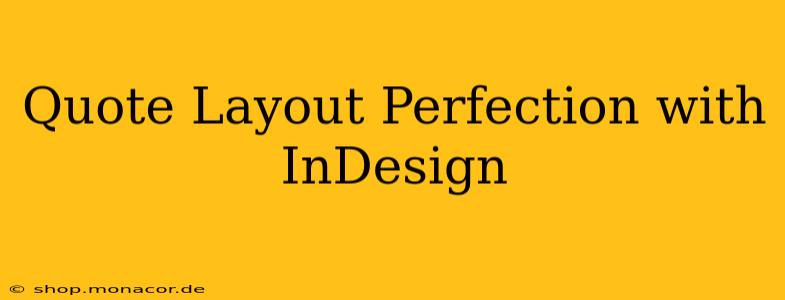InDesign is a powerhouse for graphic designers and publishers, offering unparalleled control over layout and typography. But mastering the art of quote layout, especially for impactful and aesthetically pleasing results, requires more than just knowing the software. This guide delves into the techniques and considerations for achieving quote layout perfection within InDesign, transforming simple text into visually stunning design elements.
Why is Quote Layout Important?
Before diving into the specifics, let's establish why quote layout matters. Well-designed quotes:
- Enhance readability: A visually appealing quote is easier to read and digest, increasing engagement.
- Add visual interest: They break up large blocks of text, making your publication more visually appealing.
- Emphasize key messages: The right layout elevates a quote's importance, highlighting its significance.
- Reflect your brand: Consistent quote styling contributes to a cohesive brand identity.
Common Quote Layout Techniques in InDesign
Here are some tried-and-tested methods for creating stunning quote layouts in InDesign:
1. Using Text Boxes for Quotes:
This is the most fundamental approach. Create a text box, paste your quote, and then style it using appropriate fonts, sizes, and colors. You can easily adjust the size and shape of the text box to fit your design. Consider using a contrasting background color or adding a subtle border to further highlight the quote.
2. Creating Custom Quote Shapes:
InDesign's powerful shape tools allow for highly creative quote presentations. Create custom shapes (circles, squares, irregular polygons) and then use the Type on a Path tool to wrap your quote text around the shape's outline. This method works exceptionally well for visually striking layouts.
3. Utilizing Text Frames with Drop Shadows and Effects:
Add depth and visual interest to your quotes by incorporating drop shadows, inner shadows, or other effects. These subtle enhancements can significantly improve the quote's overall impact. Experiment with different opacity levels to find the perfect balance.
4. Incorporating Images with Quotes:
Pairing quotes with relevant images is an effective strategy. Place the image behind the quote text (using transparency), or use the image as a background for the quote text box. Ensure the image complements the quote's message.
5. Employing Different Typography for Emphasis:
The choice of font significantly influences the mood and impact of the quote. Experiment with different font families, weights, and sizes to find the best match for the context and desired effect. You can also use italics or bold text for emphasis within the quote itself.
Frequently Asked Questions (FAQs) about Quote Layout in InDesign
Here, we address some common questions about quote layout in InDesign:
How do I add a source citation to my quote in InDesign?
You can add a source citation by creating a separate text box below the quote. Use a smaller font size and a different style to distinguish it from the quote itself. You can also use a hanging indent for a cleaner look.
What are the best font choices for quotes in InDesign?
The ideal font depends on the context. Serif fonts often work well for longer quotes, conveying a sense of tradition and elegance. Sans-serif fonts are suitable for shorter, more modern quotes. Experiment to find the perfect balance.
How can I ensure my quote layout is consistent throughout my document?
Use InDesign's paragraph and character styles to maintain consistency. Create styles for your quote text boxes, including fonts, sizes, colors, and spacing. This ensures that all your quotes adhere to the same design guidelines.
What are some tips for designing quotes for different media (print vs. digital)?
For print, consider using higher resolution images and more intricate design elements. For digital, prioritize clarity and readability on various screen sizes. Keep the design simple and avoid overly busy layouts.
How do I manage large quotes efficiently in InDesign?
For lengthy quotes, consider using text boxes with text wrapping options to break the text into multiple columns or paragraphs. You can also incorporate visual breaks within the quote using images or design elements.
By mastering these techniques and addressing the FAQs, you can elevate your InDesign projects with quote layouts that are not only visually striking but also enhance the readability and impact of your content. Remember to always prioritize clarity, consistency, and the overall aesthetic of your publication.

